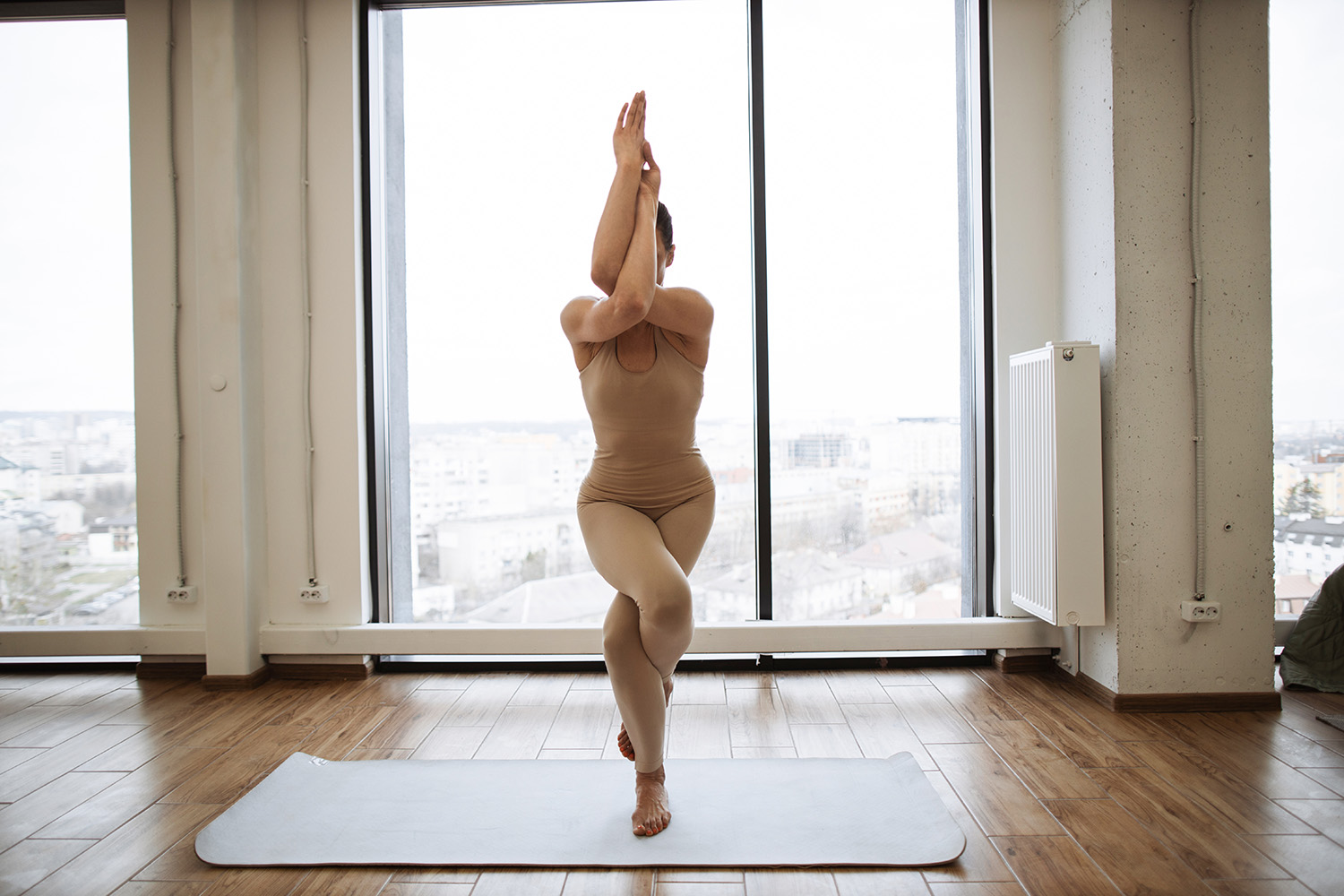Eagle Pose in yoga, also known as Garudasana in Sanskrit, is a captivating yoga pose that symbolizes strength, flexibility, and concentration. This asana encourages practitioners to intertwine their limbs like the majestic eagle, balancing grace with intensity. In this comprehensive guide, we will explore the intricacies of Eagle Pose, from its basic instructions to advanced insights, and understand its role in yoga sequences.
Other Names for Eagle Pose Yoga Pose
Eagle Pose is recognized by various names in different yoga traditions and languages. Some common alternate names for Eagle Pose include:
- Garudasana (Sanskrit)
- Feathered Peacock Pose
- Twisted Arms and Legs Pose
How to do Eagle Pose in Yoga
Proper alignment is crucial to mastering Eagle Pose. Here’s a step-by-step guide:
- Begin in a standing position at the top of your mat, with your feet hip-width apart and your arms by your sides.
- Inhale, then exhale, and shift your weight onto your left foot.
- Lift your right leg and cross it over your left thigh, hooking your right foot behind your left calf.
- Extend your arms forward and parallel to the floor, then cross your left arm over your right, bending your elbows.
- Bring your palms together, or if this is challenging, press the back of your hands together.
- Sit down into a squat, maintaining balance on your left foot. Ensure your knees are aligned, and your chest is lifted.
- Gaze forward and keep your breath steady.
- Hold the pose for 30 seconds to a minute.
- Repeat on the opposite side.
Variations of Eagle Pose Yoga Pose
Eagle Pose offers variations to accommodate different levels of practice and preferences:
- One-Legged Eagle Pose: Focus on the balance aspect by practicing with one leg crossed at a time.
- Extended Leg Eagle Pose: Extend the raised leg to a straight position for added challenge.
Modifications for Eagle Pose Yoga Pose
Eagle Pose is accessible to most practitioners, but some modifications can enhance comfort or accommodate specific needs:
- Use a Wall: Practicing near a wall can provide support if you have difficulty with balance.
- Modify Arm Position: If you can’t bind your hands, hold a strap in each hand and maintain tension between them to mimic the bind.
Contraindications for Eagle Pose in Yoga
While Eagle Pose is generally safe, there are a few contraindications and precautions to consider:
- Knee or Ankle Injuries: Individuals with knee or ankle injuries should be cautious when practicing Eagle Pose and may need to modify or avoid it.
- Shoulder Issues: If you have shoulder issues, be mindful of the arm position and avoid straining your shoulders.
Tips to Improve Eagle Pose in Your Practice
- Balanced Weight: Ensure balanced weight distribution on your standing foot.
- Tall Spine: Maintain a tall spine and engaged core to support your posture.
- Gaze Focus: Keep your gaze focused on a fixed point to enhance balance.
- Breath Awareness: Deep and steady breathing will help you find ease in this challenging pose.
What Muscles Does Eagle Pose Work?
Eagle Pose engages and strengthens various muscle groups in the body:
- Legs: Strengthens the quadriceps and calf muscles.
- Hips: Enhances flexibility and strength in the hip flexors and abductors.
- Back and Spine: Promotes good posture and strengthens the muscles of the back.
- Arms and Shoulders: Tones and strengthens the arms and shoulders.
Mental and Emotional Benefits of Eagle Pose in Yoga
Beyond its physical aspects, Eagle Pose offers numerous mental and emotional benefits:
- Concentration: Practicing Eagle Pose requires intense concentration, helping to sharpen your focus.
- Stress Relief: The pose can release tension in the shoulders and upper back, offering emotional relief.
- Patience and Determination: Overcoming the challenges of Eagle Pose fosters patience and determination.
Is Eagle Yoga Pose Suitable for Beginners and Advanced Practitioners?
- Beginners: Eagle Pose is accessible to beginners and provides an excellent introduction to balance and concentration.
- Advanced Practitioners: Advanced practitioners can work on refining alignment, exploring variations, and deepening the stretch.
How Does Eagle Pose Contribute to a Yoga Sequence or Flow?
Eagle Pose plays a significant role in yoga sequences and flows:
- Balance and Concentration: It serves as a pose that enhances balance and concentration, making it an ideal choice before moving into more challenging poses.
- Transitions: Eagle Pose can act as a transitional pose, facilitating smooth transitions between standing poses and poses involving twists or balances.
- Alignment and Mindfulness: The pose enhances alignment, body awareness, and mindfulness, setting the tone for a focused and grounded practice.
How Can I Deepen My Practice in Eagle Pose?
To deepen your practice in Eagle Pose, consider the following:
- Hold the Pose Longer: Gradually increase the duration of your Eagle Pose hold to enhance your balance and concentration.
- Practice Variations: Explore variations like One-Legged Eagle Pose and Extended Leg Eagle Pose to challenge your practice.
- Breath Awareness: Utilize your breath to deepen your connection to the pose, allowing it to guide your practice and enhance your experience.
Common Mistakes in Teaching Eagle Yoga Pose
To be an effective yoga teacher, it’s essential to avoid common teaching mistakes, including:
- Inadequate Alignment Instruction: Providing insufficient guidance on alignment can lead to improper form and discomfort.
- Neglecting Individual Variations: Not recognizing that students have different body types and abilities can hinder their experience. Encourage modifications and offer options.
- Rushing Through Transitions: Encouraging rushed transitions into and out of the pose can lead to misalignment and disrupt the flow of the practice.
- Neglecting Hands-On Assistance: Not offering hands-on adjustments when necessary can deprive students of valuable feedback and guidance.
- Monotonous Teaching: Using the same cues repeatedly can lead to boredom and lack of engagement. Vary your instructions to keep the class engaged.
- Lack of Adaptability: Failing to adjust the pose based on students’ abilities and needs can result in a mismatch and disengagement.
In conclusion, Eagle Pose (Garudasana) is a captivating yoga asana that demands strength, flexibility, and unwavering concentration. It offers numerous physical, mental, and emotional benefits, making it suitable for practitioners of all levels. Whether you’re a beginner or an advanced practitioner, focusing on alignment, variations, and the mental aspects of this pose can deepen your experience and enhance its role in your yoga journey. Through mindfulness and proper guidance, Eagle Pose can empower you to soar to new heights in your practice, just like the majestic eagle it is named after.
Namaste.

